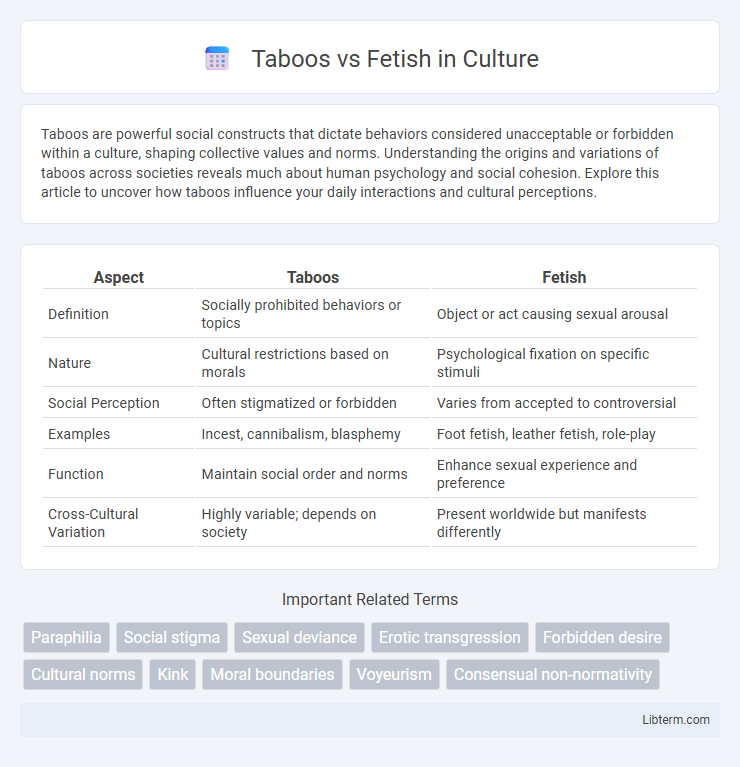Taboos are powerful social constructs that dictate behaviors considered unacceptable or forbidden within a culture, shaping collective values and norms. Understanding the origins and variations of taboos across societies reveals much about human psychology and social cohesion. Explore this article to uncover how taboos influence your daily interactions and cultural perceptions.
Table of Comparison
| Aspect | Taboos | Fetish |
|---|---|---|
| Definition | Socially prohibited behaviors or topics | Object or act causing sexual arousal |
| Nature | Cultural restrictions based on morals | Psychological fixation on specific stimuli |
| Social Perception | Often stigmatized or forbidden | Varies from accepted to controversial |
| Examples | Incest, cannibalism, blasphemy | Foot fetish, leather fetish, role-play |
| Function | Maintain social order and norms | Enhance sexual experience and preference |
| Cross-Cultural Variation | Highly variable; depends on society | Present worldwide but manifests differently |
Understanding the Concepts: What Are Taboos and Fetishes?
Taboos are culturally or socially prohibited behaviors or topics that evoke strong moral disapproval, often rooted in tradition or religious beliefs. Fetishes refer to intense sexual attraction or fixation on objects, body parts, or specific scenarios that are not conventionally considered sexual. Understanding these concepts helps differentiate societal restrictions from individual sexual interests, highlighting diverse human expressions.
Historical Perspectives on Taboos and Fetishes
Historical perspectives on taboos and fetishes reveal their deep-rooted roles in shaping human behavior across cultures. Taboos, often linked to religious or social norms, have historically governed actions by instilling fear of supernatural consequences or social ostracism. Fetishes, originating from animistic beliefs, were viewed as objects imbued with magical powers, reflecting early human attempts to exert control over the environment and personal desires.
Cultural Variations in Taboos and Fetishes
Cultural variations significantly influence the perception and acceptance of taboos and fetishes, with certain behaviors considered taboo in one society being normalized or fetishized in another. For example, food-related fetishes vary widely, where eating insects may be taboo in Western cultures but a delicacy and sensual experience in parts of Asia. Anthropological studies reveal that these cultural distinctions shape the social understanding of sexual norms, desires, and prohibitions, highlighting the fluidity and context-dependence of what is deemed taboo or fetishistic.
Psychological Roots of Taboos and Fetishes
Taboos and fetishes originate from deeply ingrained psychological mechanisms tied to human desire, fear, and societal norms. Taboos are often rooted in collective unconscious fears and cultural prohibitions that serve to regulate behavior and maintain social order. Fetishes, conversely, arise from early childhood experiences and associative conditioning, creating specific objects or acts imbued with sexual significance that bypass conventional norms.
How Society Defines and Enforces Taboos
Society defines taboos as prohibitions rooted in cultural, moral, or religious beliefs that govern acceptable behavior, often reinforced through social norms and legal regulations. These prohibitions shape collective identity and maintain social order by stigmatizing actions deemed harmful or immoral, creating strong psychological and social consequences for transgressors. In contrast, fetishes represent individual or subcultural expressions of desire that challenge societal norms but typically lack the formal mechanisms of enforcement that sustain taboos.
The Role of Fetishes in Human Sexuality
Fetishes play a significant role in human sexuality by focusing arousal on specific objects, materials, or body parts, which can enhance intimate experiences and satisfaction. Unlike taboos, which are socially proscribed behaviors often linked to cultural or moral boundaries, fetishes are generally consensual and personalized expressions of desire. Understanding fetishistic interests contributes to a broader comprehension of sexual diversity and individual psychological dynamics.
Taboos vs Fetish: Key Differences and Overlaps
Taboos and fetishes both involve elements of human sexuality, but taboos are culturally or socially prohibited behaviors, while fetishes refer to the sexual fixation on specific objects or body parts. Key differences lie in social acceptance, with taboos often viewed as forbidden or deviant, whereas fetishes can be normalized or consensual within adult relationships. Overlaps occur when a fetish involves taboo subjects, blurring lines between socially unacceptable acts and individual sexual preferences.
Media Representation of Taboos and Fetishes
Media representation of taboos and fetishes often blurs the distinction between societal prohibitions and sexual interests, shaping public perception through sensationalism and stereotypes. Films, television, and digital content tend to portray taboos--such as incest or cannibalism--as shocking or forbidden, while fetishes like BDSM or foot fetishism are depicted with varying degrees of normalization or fetishization. This framing impacts cultural attitudes by reinforcing stigmas or fostering curiosity, influencing both individual behaviors and broader social discourse.
Breaking the Silence: Stigma, Acceptance, and Dialogue
Breaking the silence surrounding taboos and fetishes challenges societal stigma and fosters acceptance through open dialogue. Addressing misconceptions about sexual preferences encourages a culture of inclusivity and respect. Increasing education and awareness promotes mental well-being and dismantles harmful stereotypes linked to personal desires.
Navigating Personal Boundaries: Respecting Differences in Taboos and Fetishes
Navigating personal boundaries requires understanding that taboos often arise from cultural or societal norms, while fetishes relate to individual sexual preferences and desires. Respecting differences involves open communication and consent, ensuring that all parties feel safe and acknowledged in their limits. Recognizing the distinction between these concepts fosters empathy and healthy interactions in diverse social and intimate settings.
Taboos Infographic

 libterm.com
libterm.com